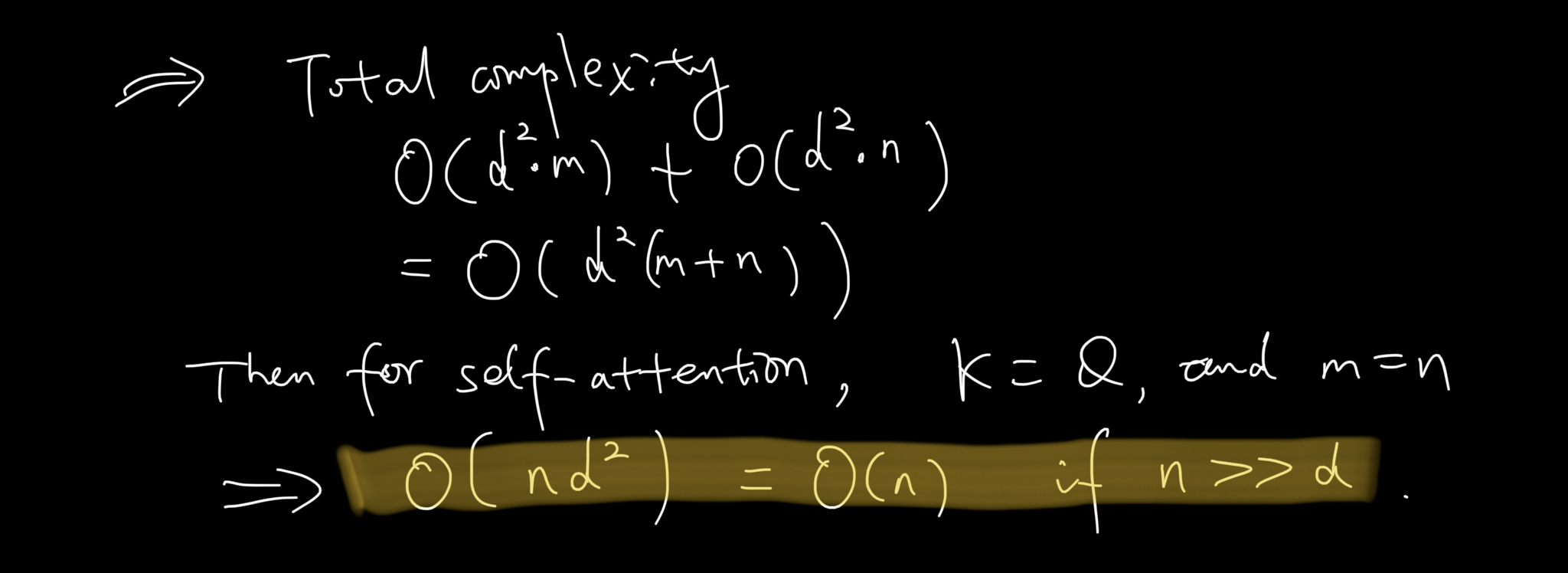Attention and Linear Attention
Attention vs Linear Attention
Please see this figure which compares regular attention vs linear attention. This figure is copied from the paper Efficient Attention: Attention with Linear Complexities or the github repo Linear Attention Transformer.

Figure 1: Illustration of the architecture of dot-product and efficient attention.
Attention
See this paper Attention Is All You Need.
Study Notes
See the following study notes about this regular attention.
- Definition

- Complexity

- Interpretation

- Implementation

Linear Attention
See the paper Transformers are RNNs: Fast Autoregressive Transformers with Linear Attention and the paper Efficient Attention: Attention with Linear Complexities.
Study Notes
See the following study notes about linear attention.
- Definition

- Complexity

- Implementation

How to understand the context $C$?
See 3.2 Efficient attention from Efficient Attention: Attention with Linear Complexities
Efficient attention uses each of these feature maps as a weighting over all positions and aggregates the value features through weighted summation to form a global context vector. The name reflects the fact that the vector does not correspond to a specific position, but is a global description of the input features.
Code Implementation
-
The code is copied from simple_diffusion.py implemented by Phil Wang.
-
See this repo Linear Attention Transformer,
class Attention(nn.Module):
def __init__(self, dim, heads=4, dim_head=32):
super().__init__()
self.scale = dim_head**-0.5
self.heads = heads
hidden_dim = dim_head * heads
self.to_qkv = nn.Conv2d(dim, hidden_dim * 3, 1, bias=False)
self.to_out = nn.Conv2d(hidden_dim, dim, 1)
def forward(self, x):
b, c, h, w = x.shape
qkv = self.to_qkv(x).chunk(3, dim=1)
q, k, v = map(
lambda t: rearrange(t, "b (h c) x y -> b h c (x y)", h=self.heads), qkv
)
q = q * self.scale
sim = einsum("b h d i, b h d j -> b h i j", q, k)
sim = sim - sim.amax(dim=-1, keepdim=True).detach()
attn = sim.softmax(dim=-1)
out = einsum("b h i j, b h d j -> b h i d", attn, v)
out = rearrange(out, "b h (x y) d -> b (h d) x y", x=h, y=w)
return self.to_out(out)
class LinearAttention(nn.Module):
def __init__(self, dim, heads=4, dim_head=32):
super().__init__()
self.scale = dim_head**-0.5
self.heads = heads
hidden_dim = dim_head * heads
self.to_qkv = nn.Conv2d(dim, hidden_dim * 3, 1, bias=False)
self.to_out = nn.Sequential(nn.Conv2d(hidden_dim, dim, 1),
nn.GroupNorm(1, dim))
def forward(self, x):
b, c, h, w = x.shape
qkv = self.to_qkv(x).chunk(3, dim=1)
q, k, v = map(
lambda t: rearrange(t, "b (h c) x y -> b h c (x y)", h=self.heads), qkv
)
q = q.softmax(dim=-2)
k = k.softmax(dim=-1)
q = q * self.scale
context = torch.einsum("b h d n, b h e n -> b h d e", k, v)
out = torch.einsum("b h d e, b h d n -> b h e n", context, q)
out = rearrange(out, "b h c (x y) -> b (h c) x y", h=self.heads, x=h, y=w)
return self.to_out(out)